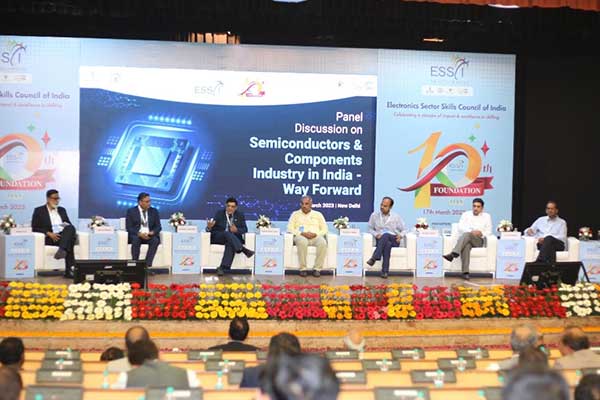Electronics Sector Skills Council of India (ESSCI) celebrated its 10th foundation day on 17th March at the NDMC Convention Centre in New Delhi. On the occasion, ESSCI organised a panel discussion on “Semiconductor and Component industry in India: Way Forward.” The panel was moderated by Ashwini K. Agrawal, Director, Applied Materials India. The panel featured distinguished speakers from the government, academia, and the semiconductor industry.
In his opening remarks, Ashwini mentioned the crazy excitement he has seen on the electronics shopfloor in the country in the last few years. He said, “Electronics manufacturing is here today and we are in an exciting threshold where semiconductor and the component industry is going to take a step up and rise to sync in with that and create an additional value addition for the nation.” He further appreciated SCL, Chandigarh for powering India’s space program with its chips that are not found easily in the global market.
The first question of the discussion was addressed to Mukesh Chopra, Director, Microcontroller and Discrete IC group, MDG and R&D, STMicroelectronics India. He was asked about the key trends in semiconductors w.r.t how it is evolving and the workforce that is coming.
Answering the question, Mukesh highlighted the fact that electronics becoming part of our life, from the time we wake up till the time we sleep, as the macro trend behind the growth of the semiconductor industry. Further, Mukesh pointed out some specific trends. The energy was the first one in the list that has two elements- Efficiency and Renewables. This is important as the world is trying to move towards carbon neutrality.
Another one was mobility where electronics instruments are employed for the safety of precious lives and electrification of mobility was another aspect of it, not just 4-wheelers but even two-wheelers. Mukesh said, “This is an opportunity where India can shine and outsmart the world because we are the leader amongst 2-wheeler and with this EV drive we can take this forward.” The last trend that Mukesh highlighted is IoT, 5G and the upcoming up Gs.
Talking about the workforce in the industry, Mukesh said, “The industry witnessed the talent war last year.” The talent war is the term used to find the right talent. He further appreciated the workforce in India. He said, “After the Bay area in the US, India is the country where this talent is available for the industry and companies are investing in India due to the availability of this talent.” On a cautionary note, Mukesh added, “but this is not sufficient we need to continue and improve. So that the raw talent which is coming from the engineering college can be leveraged.”
Answering the same question from the packing industry perspective, George Paul, Director of Sahasra Electronics Private Ltd appreciated the Indian workforce in the VLSI space which was created due to outsourcing of work. However, he highlighted the dearth of talent in the other areas of semiconductor value addition like fabrication, packaging, and packaging design. He said, “this gap has to be met if we have to succeed.” Further, illuminating on the requirements of the Packing and Packing Design industry, George said, “Packing and Packing Design industry needs engineers from material science, mechanical and chemical engineers.” The industry needs skilled people on the shop floor. George said, “Operators of the machine, process engineer, design engineer, quality engineer- these are the skills that people need to make.”
George further remarked, “we have people with basic knowledge, we have to skill them to meet the need of the industry.” Based on this experience in HCL, George suggested the following ways to create the necessary workforce in a shorter time period:
- Bring ex-pats from abroad to come here and work for 2-3 years.
- Government should focus on providing support and the industry should attract them with salaries.
- Labs should be set up for thermal, moulding, chemical composition and packaging design.
Rakesh Adhikari, Director, Incise Infotech Pvt. Ltd. answers the question from the design industry point of view. He said, “The talent which is coming from the tier 2 and 3 colleges is not readily deployable on the shop floor.” He demanded some infrastructure to train this student for the industry. Further, he said, “Instead of producing general electronics engineers the college should be more skill set oriented like VLSI engineers and packaging engineers.”
On being asked about the government’s efforts to fill the skill gap, Prashant Kumar, Scientist ‘E’, Ministry of Electronics and Information Technology, said, “We have launched the Semicon India program in which we are incentivising setting up of the semiconductor fab facilities, display facilities and ATMP facilities. It includes design-linked incentives also.”
Particularly focusing on skill development, Prashant said, “All schemes have set aside a certain portion of its outlay for R&D and skill development.”
Further, highlighting the schemes for manpower development, Prashant said, “Specialised manpower development program has now converted into Chips to Startup program where we are targeting around 85000 skilled manpower to be developed in 5 years. There are 120 organisations that will be benefitted. Already 105 have been selected in 1st round out of which 90 are academic institutes.”
Illuminating on the facilities that are being provided by the government, Prashant said, “We are providing infrastructure in terms of state-of-art EDA tools through WAN networks. Students are going to get exposure to design. Those designs will be fabricated through this program. We have SCL if anything is to be fabricated above 180 nm. If anything has to be fabricated at an advanced node, we have tie-ups. Students will get exposure to fabrication methodologies and validation.”
On being asked about the role of an academic institution like IIT Jodhpur in developing a talented semiconductor component electronics workforce, Ajay Agrawal, Professor and Head of the Department of Electrical Engineer, IIT Jodhpur, said, “There is a gap. The courses or diplomas that are offered in most of the engineering colleges do not give hands-on training to anyone at the B-Tech level.”
“Training is given when you can change the process and different parameters and see what is the effect of it. There is a lot of need and these can be done in facilities that are tuneable. Unfortunately, the government has not supported these facilities yet,” he further added.
On course requirements, Ajay said, “We need more certification on skill program to develop and strengthen the semiconductor sector.”















